#Hindu devotionals Channels
Text
श्रीमद भागवत कथा | स्वामी शैलेषानंद जी महाराज |Bhagwat Katha
View On WordPress
#aastha#aniruddhacharya ji live#aniruddhacharya ji maharaj#bhagwat katha#bhagwat katha live#bhajan#bhakti#devotional#gods#hindu#katha#manushri ji live#motivation#Nistha Dhawani#ram katha#sadhna#sadhna channel#sadhna tv#sadhna tv live#sanskar#Sheleshanand ji#shrimad bhagwat katha#shrimad bhagwat katha live#spiritual#spiritual channel#Swami Shaileshanand Ji Maharaj#tv#श्रीमद भागवत कथा#स्वामी शैलेषानंद जी महाराज
0 notes
Text
Asteroid Kaali 4227
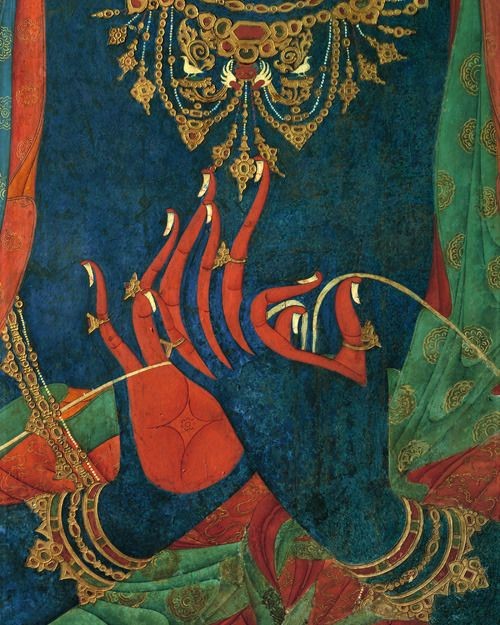
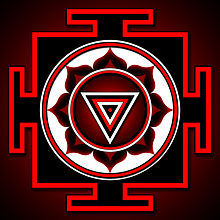
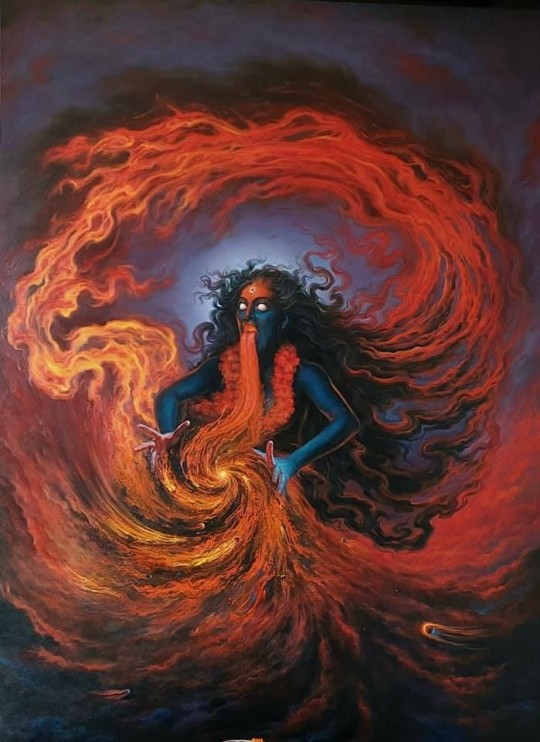
Mythology:
Also referred to as Mahakali, Bhadrakali, and Kalika (Sanskrit: कालिका), is a Hindu goddess who is considered to be the goddess of ultimate power, time, destruction and change in Shaktism.[1] In this tradition, she is considered as a ferocious form of goddess Mahadevi, the supreme of all powers, or the ultimate reality. She is the first of the ten Mahavidyas in the Hindu tantric tradition.She is regarded as the ultimate manifestation of Shakti, the primordial cosmic energy, and the mother of all living beings. The goddess is stated to destroy evil in order to protect the innocent. Over time, Kali has been worshipped by devotional movements and Tàntric sects variously as the Divine Mother, Mother of the Universe, Principal energy Adi Shakti .She is also seen as the divine protector and the one who bestows moksha, or liberation.
As per my interpretation the placement of asteroid kaali in someone's chart is somewhere they are blessed with divine power to put efforts and change things, the placement of ultimate power , somewhere they can start their tantra /spiritual practices with , place where they can attain moksha, where Kali protects .
Placements:
First house/Aries
You have the principle power over yourself you know yourself and your motives and you know how to use your own inner energy to cultivate change within yourself and with others, your attainment of spirituality in this lifetime would be through yourself, through working on your body , observing others etc. You are protected by Kali when it comes to wounds and physical ailments, she would be helpful for you to receive guidence in matters of self confidence and growth , in becoming your best self , she could be a guide to your dark feminine aspects.
Second house/Taurus
When it comes to your attainment of power it comes through sense of possession , buying things , mostly things which match your aesthetic value , you have the power to make a lot for yourself if you choose to step into it , your power comes from your stable subtle beauty and eye for it , your spiritual practices can begin with a fair ground to improve your allure , glamour magick or enchantment, you will be protected in your finances .
Third house / Gemini
Your voice is your awakening, your opinions your weapons , you are the trigger, your power lies in accepting your voice , using it for the good , you could also use manipulation for getting things you want , your affirmations and mantras could be your initiation to your practices, you can even receive mantras in dreams if you wish to , you could have oracular abilities as well.
Fourth house/ Cancer
Your sense of security is your foundation, you're the embodiment of the mother type in triple goddess symbolism, you're fertility in full bloom , your power lies in protection , birthing of new ideas , creativity, your power sterns from love , you could do protection magic as well as magic that involves feeling your sexual energy, as well as moon magic . Take a note of your energy on full moon.
Fifth house / Leo
This gives very much "The love witch " vibe, your transformation is through love your transcendence is through love , with young love in your heart and forever in your mind you can create the life that you want , you could be blessed with great deal of manifestation, since Kali protects this area for you , you will be ripped off from any wrong person in love , and eventually the right person will come into your life . You're esoteric, you could start with channeling your daimon however be careful.
Sixth house/ Virgo
Healing is something that you can do , not just for yourself but for everyone around you , in the physical realm as well , you know the people say so and so doctor has magic within them they cured someone no one else could , that kind of magic , you can choose to heal people and yourself, starting with reiki and small healing spells , making potions as well . Regardless of the good side you have the thing about inflicting pain and vodoo as well , but do it to the bad people who deserve the pain .
Seventh house /Libra
Your power lies in relationships that you make , you derive so much love and support from them that it helps you in your practices as well , your vivid imagination as well helps you get so many things , your partner could be source of magic , you can do spiritual things together and based on the foundation of counterpart energy you guys can grow together . Kali will protect the relationship that is right for you.
Eighth house / Scorpio
You're the embodiment of transformation true form of dark feminine, you derive power from sexual practices, from changes from the things that kill you , you make them their power, sex magic could be a great option for you . Kali will protect you in areas of your transformation, whenever you are brought down remember you will definitely rise above greater
Ninth house / Saggitarius
Wisdom and education are so important for you to get the power that you deserve, you're intelligent and mindful and that will lead to you getting the most in life , you could be a guru , you could do great in philosophical fields. You can write sacred literature and esoteric books , your knowledge is sacred and will be protected
Tenth house/ Capricorn
You're methodical and know how to do things the right way that is your greatest power , you will hardly fuck up anything because you are so into working hard and making things perfect, with great connections you will lead an easy pathway to success. You will be granted ample strength in doing what you put your heart to.
Eleventh house / Aquarius
This placement very much reminds me of the origin of Kali , please read on it for greater information, the point where she goes on destroying the evil around her , you guys will be blessed by Kali to maintain yourself even in the times of extreme chaos, she will look after, you have a very great power to change things through rightful violence, violence works for you , use it wisely tho.
Twelfth house/ Pisces
Your power is your strong almost blurring intuition, visions , you know so much but do you tell them enough, if you pray to Kali and wish for her to come visit you in her dreams she will , she will guide through the spiritual part in your life , worshipping her will be life changing in subconscious ways , even i cannot explain.
Thank you so much for reading i hope this helped take care love love .
#astrologer#astrology signs#astrology#astrology asteroids#asteroids in astrology#astro community#tropical zodiac#sidereal astro#asteroid astrology#asteroids astrology#astrology community
1K notes
·
View notes
Text
Chakras - What they really are

(I managed to salvage this post written by @rue-cimon from an old deactivated account. I copied it down here because this was too good a post to lose.)
Chakra literally means "wheel" or "circle" in Sanskrit. The concept of chakras originates from Hinduism in ancient India. These are focal points used in a variety of ancient meditation or yoga practices. These practices are collectively called "tantra".
Although the concept is frequently found in early traditions of Hinduism and are often mentioned in the Vedas, beliefs around chakras differ between various Indian religions. Buddhist texts consistently mention 5 chakras, whereas Hindu texts and sources speak of 6 or 7 chakras.
Early Sanskrit texts speak of them both as meditative visualizations combining flowers and mantras and as physical entities in the body. Within kundalini yoga, various breath exercises, visualizations, mudras, kriyas, and mantras are focused on manipulating the flow of subtle energy through chakras.
Chakras are also present in Ayurvedic traditions.
The belief behind chakras is that human life simultaneously exists in two parallel dimensions, one is the physical body and the other is psychological, emotional, mind, non physical (the subtle body).
The aforementioned subtle body is energy, while the physical body is mass. The psyche or mind plane corresponds to and interacts with the body plane, and the belief holds that the body and the mind mutually affect each other. The subtle body consists of energy channels connected by nodes of psychic energy called chakras.
The chakras - in Hindu and Buddhist texts - are said to be arranged in a column along the spinal cord, from its base to the top of the head, connected by vertical channels. Tantric traditions strive to awaken, master, and energize these chakras through yoga and often with the help of a teacher.
The esoteric traditions in Buddhism generally teach four chakras. In some early Buddhist sources, these chakras are termed as manipura (navel), anahata (heart), vishuddha (throat), and ushnisha kamala (crown). However, a system of five chakras is common among classes of tantra in Tibetan Buddhism. These five chakras are basal, abdominal, heart, throat, and crown, and each chakra corresponds with an element, a Buddha, and a bija mantra.
The more common and most studied chakra system incorporates six major chakras along with a seventh center generally not regarded as a chakra.
The chakras are traditionally considered meditation aids. The yogi starts from lower chakras and progresses to the highest chakra located in the crown of the head, in the journey of spiritual ascent.
In the Hindu kundalini and Buddhist candali traditions, the chakras are pierced by a dormant energy residing near or in the lowest chakra. in Hindu texts she is known as Kundalini, while in Buddhist texts she is called Candali or Tummo.
Some terms and definitions:
Tantra: Esoteric traditions in Hinduism and Buddhism that developed in India mainly during the middle of the 1st millennium CE. The term tantra, in the Indian traditions, also means text, theory, system, method, instrument, technique, or practice. A key feature of these traditions is the use of mantras.
Kundalini yoga: A type of yoga focused on channeling energy through the chakras.
Mudra: A symbolic or ritual gesture or pose in Hinduism, Jainism, and Buddhism. Mudras have meaning in many forms of Indian dance and yoga. In hatha yoga, mudras are used in conjunction with pranayama (yogic breathing exercises), generally while in a seated posture, to stimulate different parts of the body involved with breathing and to affect the flow of prana and is associated with consciousness in the body. Mudras are also used in tantric practices.
Kriya: Practice within a yoga discipline meant to achieve a specific result. The Yoga Sutra of Patanjali defines three types of kriya, namely asceticism, study, and devotion. Such yoga is called kriya yoga. Kriya is a Sanskrit word that literally means "to do" or "to work".
Mantra: A sacred utterance, a sound, a syllable, word, or phonemes, or group of words in Sanskrit, Pali, and other languages. They hold spiritual and religious significance. At its simplest, the word "om" serves as a mantra. It is believed to be the first sound which was originated on earth. It creates a reverberation in the body which helps the body and mind to be calm. In more sophisticated forms, mantras are melodic phrases with spiritual interpretations such as a human longing for truth, reality, light, immortality, peace, love, knowledge, and action. Not all mantras have literal meanings but rather are simply uplifting.
Ayurveda: An alternative medicine system with historical roots in ancient India.
#chakras#hinduism#buddhism#witches of color#asian religions#eastern spirituality#ancient india#asian witches#buddhist witches
269 notes
·
View notes
Text
Aniruddhacharya ji Vs Sant Rampal Ji | Ep-05 | तत्वदर्शी संत कौन होता है...
youtube
#हिन्दू_भाई_संभलो
DO NOT BETRAY HINDUS
It is against the belief of devotion to dance.
नाचे गाये किन्हं न मिल्या। जिन मिल्या तिन रोय। नाचे गाये हरि मिले तो कौन दुहागन होय ।।
Hindu Bhai Dhokhe Mein
#HinduBhai_Dhokhe_Mein
#Hindu #Hinduism #HinduTemple #Hindiquotes #Sanatani #SanatanDharma
#SantRampalJiMaharaj
#BhagavadGita
↪️⛲अधिक जानकारी के लिए संत रामपाल जी महाराज द्वारा लिखित पुस्तक "ज्ञान गंगा" फ्री में ऑर्डर करे ⤵️
https://docs.google.com/forms/d/e/1FAIpQLSc2SCilCt8isyNVt97-LUUrIBX_JgG_fbAoMOoXgWMacEBqTg/viewform?usp=sf_link
या
अपना नाम ,पूरा पता, पिन कोड ,मोबाइल नंबर हमें Whatsapp करें +91 7496801825
पुस्तक और डिलीवरी चार्ज बिल्कुल निःशुल्क (फ्री) है।
🫴🏻 अब संत रामपाल जी महाराज जी के मंगल प्रवचन प्रतिदिन सुनिए....
🏵️ Nepal 1 टी.वी. पर सुबह 6:00 से 7:00 तक
🏵️ श्रद्धा MH ONE टी. वी. पर दोपहर 2:00 से 3:00 तक
🏵️ साधना टी. वी. पर शाम 7:30 से 8:30 तक
🏵️ POPULAR TV पर शाम 07:30 बजे से 08:30 बजे तक
📣 Visit 👉 Sant Rampal Ji Maharaj YouTube Channel.
6 notes
·
View notes
Text
Satan rolled his eyes. "You seeing this shit, Steve?" he asked his personal assistant, pointing to the gigantic stadium-sized TV in his throne room.
"...Respectfully, Your Wrathfulness: what 'shit', specifically?"
"These knee-jerk reactionary crybabies bitching and moaning about the opening ceremony for the Summer Olympics!" the Sin began to explain before launching into vicious mockery.
"'OWO, SO SATANIC! AN AFFRONT TO CHRISTENDOM, UWU! WHO AWWOWED SUCH A BWASPHEMOUS CEREMONY TO TAKE PWACE? HOW CAN THE WORLD COME TOGETHER IN THE SPIWIT OF SPORTSMANSHIP WITH SUCH DIVISIVE ANTI-CWISTIAN WHETORIC SHOVED DOWN OUR THWOATS, UWUUU~'"
"First of all, I had NOTHING to do with this. I did not put Lady Gaga and a bunch of drag performers up to this, I did not give this ceremony my blessing, none of my cultists were involved on any level and not a single fucking pentagram or 'Hail Satan' can be found on that stage. Where in yon fuck are these humans getting 'Satanic' vibes?"
"Secondly, PULL YOUR HEADS OUT FROM THINE CAVERNOUS ASSES AND TAKE A WHIFF OF FRESH AIR! Not everything is about you! Nothing about what happened on stage was about you! What they performed was 'the Feast of Dionysus'. Anyone calling it 'The Last Supper' is not only factually wrong, but grossly uncultured swine."
"Third and MOST importantly: Christ-stans, you are NOT the 'poor widdle uwu so oppwessed' demographic anymore! You haven't been the minority since the fucking Council of Nikea---which was, -knock knock- Hellooo~, 1700 YEARS AGO! In a global population of 8 billion, your religion comprises over 2.2 billion. Add your Abrahamic cousins and you outnumber Hindus and Bhuddists combined."
"You are not being crucified. You are not being thrown to lions as food. You are not being immolated as human tiki torches for monarchs' garden parties. You are not getting dragged outside your homes and told 'renounce Jesús' or die. Your churches and monasteries aren't being looted by Vikings."
"Every developed suburb has at least one local church per square mile, at minimum. For a lot of the Western world, you got as many churches as McDonald's and Starbucks locations---denominations aplenty! You even have hundreds of channels devoted to providing sermons on the hour, if you somehow can't reach any of God's houses."
"But go ahead: keep on bitching and moaning about people not doing exactly what you want. Keep hating anyone different. Keep throwing your children under the bus because they want to do more than dance to your little tune forever. Keep trying to outlaw what you don't like or understand. Keep trying to transform public schools into churches. Keep telling young women 'Don't go to college, get a man'. That'll definitely put asses in the pews!"
2 notes
·
View notes
Text
Narendra Modi’s electoral success in Gujarat between 2001 and 2014 and on the Indian scene since then stems from his novel blend of populism and Hindu nationalism (Hindutva). Hindutva grew out of the Rashtriya Swayamsevak Sangh (National Volunteer Organization, RSS), a paramilitary-style nationalist group founded in 1925 to bulk up young Hindus both physically and morally so they could stand up to Muslims, who were depicted as a danger to the majority.
Modi joined the RSS as a child and devoted his life to it, pursuing no other careers and even living apart from his wife. He rose through the ranks, eventually becoming the chief minister of Gujarat (his home state) in 2001. The following year, he oversaw an anti-Muslim pogrom that left some 2,000 dead— a strategy of religious polarization that won him the December 2002 regional elections. Similar successes in 2007 and 2012 made Modi the obvious prime ministerial candidate for his Bharatiya Janata Party (Indian People’s Party, BJP) in 2014.
But he left behind the RSS tradition of collective decision-making, putting himself front and center and striving to connect directly with “his” people. Rather than relying on the activist network, Modi held rally after rally where he showcased his flair for speechmaking. He also founded his own television channel, worked social media, and employed a revolutionary strategy: using holograms to simultaneously lead one rally in hundreds of places. Modi even distributed masks printed with his likeness to deepen supporters’ identification with him. In short, he saturated the public arena so as to embody the masses—a task made easier by his low-caste origins, on which he has built a complete narrative. (He worked as a teaboy in his father’s shop.)
However, the “masses” meant only the Hindu majority, which he was busy stirring up against one target in particular: Muslims. As in the 2014 elections, in 2019 “Moditva”—Modi’s idiosyncratic hybridization of right-wing nationalist ideology, Hindutva and a personality cult—triumphed on the strength of BJP landslides in the north and west. This success allowed him to bend to his will both the RSS and the BJP—whose MPs had ridden to victory on his coattails—fashioning a government of faithfuls and a parliament of yes-men.
The other institutions soon succumbed too—even the Supreme Court, once a beacon of independence. In the summer of 2014, Modi advanced a constitutional reform that would have changed the appointment process for judges, until then picked by a collegium of peers. His co-optation, opposed by the entire political class, would have replaced the collegium with a five-member commission. The Supreme Court eventually declared the amendment unconstitutional, but Modi still got his way: Of the nominees submitted by the collegium, his government finalized appointments only for those he liked. The court thus resigned itself to proposing candidates who were apt to please him.
continue reading
6 notes
·
View notes
Text
the meaning of Agni: his name**
growing up as Arshad Satyendra Iyer in a privileged socio-economic class, he lost his faith after seeing his father face no consequences for his many immoral actions. without any particular connections to others, he did whatever put him ahead in life. in his case, it led to injuring and murdering innocent people
after being caught and sentenced to death, he didn't care about his incoming execution because he didn't have anything/one to live for- then Soma cut the rope and declared him a new man, one named Agni
any small amount of research will tell you that Agni is the name of a Hindu god of fire who is a messenger between humans and the divine. not only does "rebirth in fire" parallel the fact that he left his old life completely behind to begin anew, but his divine strength being channeled through a human body particularly mirrors his namesake
and why does he live now? for Soma. his connection to the world, which is why his devotion to the prince is so strong and all-encompassing. he's never had a reason to want to live before Soma started his life over
next in #agnicharacterprogression I'll look into his connection with Soma
**Agni's and Soma's character traits are somewhat based off of Japanese stereotypes about Indian people, which I am trying to not reinforce, but if you spot any mistakes please let me know!
#agnicharacterprogression#agni character progression#black butler 2024#agni black butler#black butler#soma asman kadar#if there's not a somagni renaissance then what's the goddamn point of this godforsaken place
6 notes
·
View notes
Text
Navratri 2023 Colors: A Guide to the Significance of 9 Days of Sharad Navratri Attire
Navratri, the nine-night festival dedicated to the worship of Goddess Durga, is celebrated with great enthusiasm and devotion in India, especially in states like Maharashtra and Gujarat. One of the captivating traditions during Navratri is the daily choice of colors to wear, each associated with a different form of the goddess. This practice holds deep significance in Hindu culture, symbolizing purity. Let's take a closer look at the Navratri colors to be followed this year and the gods and goddesses they represent.
Day 1: Pratipada - Shailputri
On the first day of Navratri, Goddess Shailputri is venerated, also known as Parvati, the daughter of the Himalaya mountains. The color for this day is Orange, symbolizing energy and enthusiasm.

Image Courtesy: Pinterest
Adorn yourself in an elegant Orange and red Ikkat Pure Pochampally Handloom Saree to honor the goddess's strength and grace.

Day 2: Dwitiya - Brahmacharini
Mata Brahmacharini, the goddess celebrated on the second day, signifies eternal peace. White, the color of serenity, is the choice for Day 2.
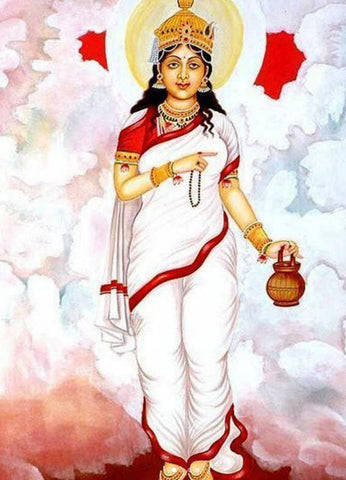
Image Courtesy: Online live daily news
A Pearl White Color Mirror Work Viscose Rayon Navaratri Lehenga Choli reflects the goddess's tranquil and pure nature.
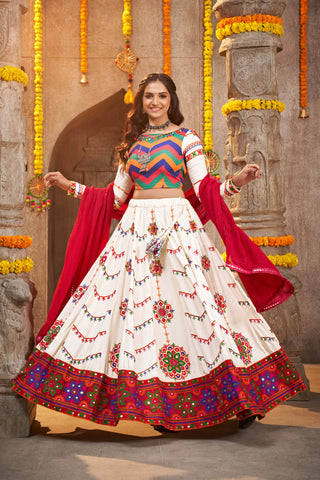
Day 3: Tritiya - Chandraghanta
On Tritiya, we worship Mata Chandraghanta, who rides a lion and is believed to vanquish evil forces. Red, the color of health, courage, and love, is the color of choice.

Image Courtesy: Pinterest
Embrace this vibrant hue with a Red saree cutdana work to channel your inner strength.
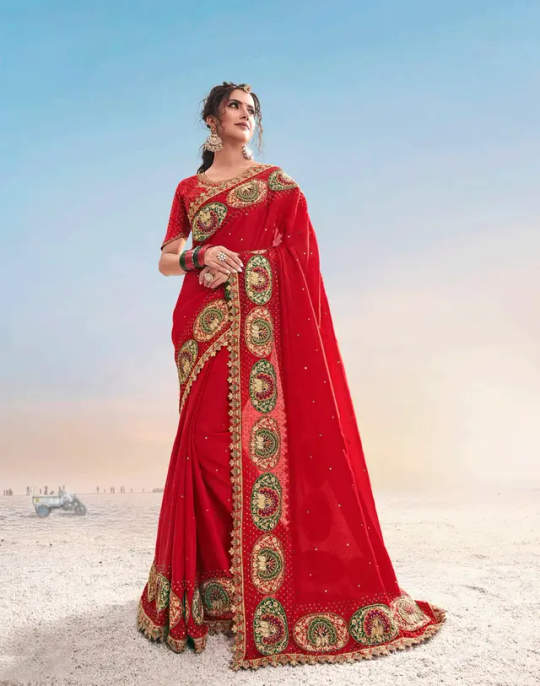
Day 4: Chaturthi - Kushmanda
The fourth day celebrates Mata Kushmanda, who is said to have created the cosmic egg with her smile, bringing light to the universe. Royal Blue, representing elegance and royalty, is the color for this day.

Image Courtesy: Pinterest
Grace the occasion with a splendid Navratri Chaniya Choli in this mesmerizing shade of Blue.
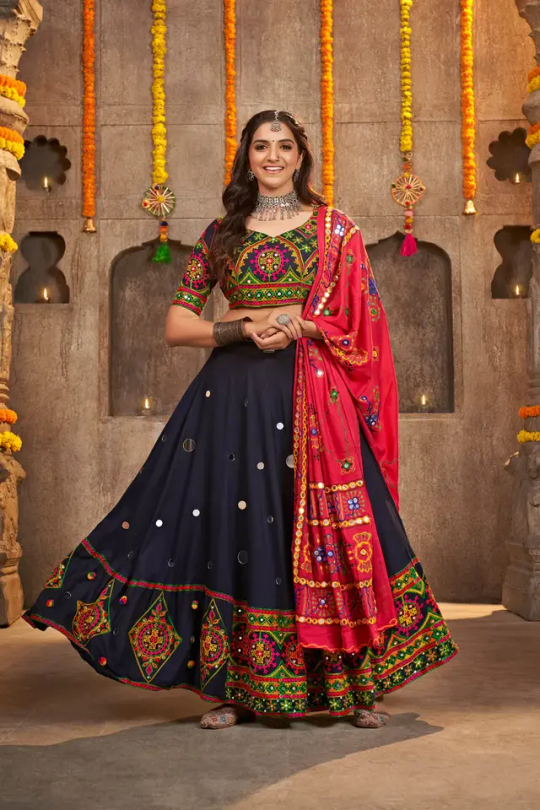
Image Courtesy: Pinterest
Day 5: Panchami - SkandMata
Mata Skandmata, honored on the fifth day, is associated with good health. This day is dedicated to Green, symbolizing nature and prosperity.

Image Courtesy: Pinterest
Wear this beautiful green saree to align with the goddess's blessings.

Day 6: Shashthi - Katyayani
Mata Katyayani, the sixth form of Mata Durga, is the granter of health and happiness. Grey, a vibrant and versatile color, is chosen for this day's celebrations.

Image Courtesy: Pinterest
Grace the occasion with a Grey Anarkali Dress
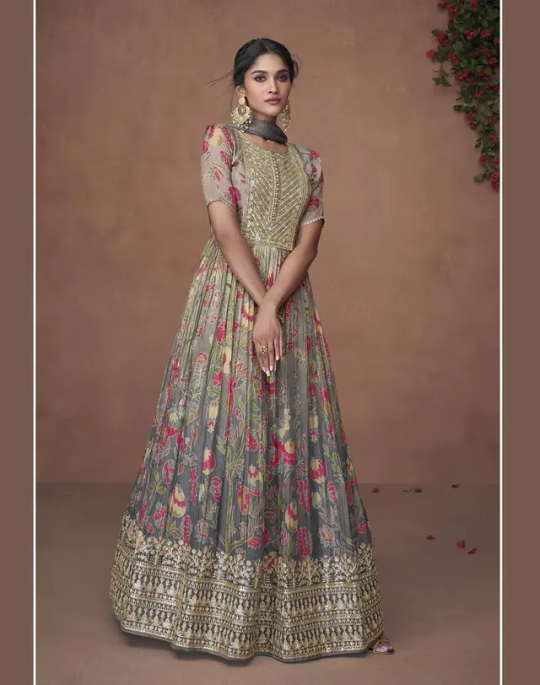
Day 7: Saptami - Kaalratri
Maa Kaalratri, worshipped on the seventh day, protects against evil forces. Orange is the color for Saptami, reflecting the fervor of Navratri celebrations.

Day 8: Ashtami - Mahagauri
Maa Mahagauri, associated with peace and intelligence, is revered on the eighth day.

Image Courtesy: Pinterest
Adorn yourself in Peacock Green indian saree, a sublime shade that complements the goddess's virtues.

Day 9: Navami - Siddhidatri
On the ninth and final day, we honor Maa Siddhidatri, the granter of divine blessings. Pink, a combination of the energy of red and the stability of blue, is chosen. This color symbolizes opulence and richness as we seek the goddess's supreme blessings.

Image Courtesy: Pinterest
During Navratri, people wear different colors each day to show that they are all together and devoted. It's like a colorful journey through different forms of the Goddess Durga, who is very special. When you celebrate Navratri, make sure to wear colors that show how much you love and respect the divine.
Explore the exquisite collection of Navratri attire at Mohi Fashion, featuring enchanting Chaniya Choli, Navratri Ghagra Choli, Anarkali suit, sarees, and stylish sharara suit, all available online. We proudly offer worldwide shipping, catering to fashion enthusiasts in the USA, Australia, UK, Canada, India, and beyond. Join us in celebrating the spirit of Navratri with elegance and style.
#navratri#lehenga#indian ethnic wear#sareelove#sareeonline#bride#wedding#indianfashion#sareecollection#bollywood#bollywood actress#ootd
2 notes
·
View notes
Text
8 Most Famous Festivals in India
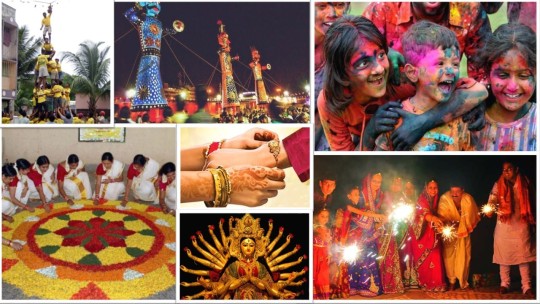
India is known for its multitude of festivals and the peaceful coexistence of people from different religious backgrounds. These festivals are a true representation of India's rich cultural heritage and traditions. There are several festivals and celebrations. While there are celebrations throughout the year, the country is at its most colorful from October to January. Every religion and community in India practice their own culture and enjoy it to the fullest. India celebrates holidays according to state, religion, and society. Festivals in India are never ending and every day is something to celebrate.
Diwali
The nation commemorates Lord Rama's homecoming to Ayodhya after a 14-year exile by lighting diyas, making rangolis, adorning homes, donning new garments, giving out presents, and setting off fireworks. People also revere Lord Ganesha, who represents moral beginnings, and Goddess Lakshmi, the Goddess of riches and prosperity. In West Bengal and Odisha, it is referred to as Kali Puja. It is known as Bandi Chor Diwas in Sikhism, and around this time, worshippers light the Golden Temple of Amritsar and enjoy fireworks displays. All around the nation, Diwali melas are organized. In Karnataka, there is a five-day celebration, which can be witnessed during India tours. In the Braj region, Diwali is devoted to Lord Krishna, and as a result, they worship Govardhan Mountain. There is a lot of fervor and spectacle around the Festival of Lights.
Republic Day
India became a republic on January 26, 1950, when the Indian Constitution went into effect. Since then, Indians have proudly celebrated the national holiday on January 26 each year. The festivities take the form of ceremonial marches at Rajpath in front of the Indian President and other foreign dignitaries. Numerous thousands of people come to the venue to watch the spectacle showcasing the nation's unity and cultural diversity. You need to register for this event from government websites during your India tour packages.
Holi
The festival of colors is the friendliest holiday in the nation. The night before Holi is Holika Dahan, when all negativity is burned in a bonfire. People play with organic colors while grooving to music on the main day. The festival's signature dishes include Gujiya, Mathri, and Thandai. In the Mathura district of Bhaj, Lathmar Holi is observed. Sticks were used by women to amusingly beat their husbands' shields. Offerings are made to Kamadeva, the Hindu god of love, throughout the south. In Gujarat's coastal city of Dwarka, the event is observed at the Dwarkadheesh Temple. It is celebrated as the holiday of reconciliation and fresh starts.
Rath Yatra, Puri, Orissa
The largest celebration observed in Puri is the Rath Yatra. In Puri's primary Jagannath temple, the deities Lord Jagannath, Lord Balabhadra, and Goddess Subhadra are carried away on the heavenly wheel and placed in their corresponding chariots. The chariots are then driven up to the Gundicha Temple's grand avenue. Participants in this Yatra number in the thousands. This Yatra is also shown live on foreign channels.
Krishna Janmashtami
The birth of Lord Krishna is commemorated each year by a Hindu event. The holiday is observed differently in each state. The traditional Krishna play, Rasa Lila, is performed throughout the states of Gujarat, Manipur, Assam, Rajasthan, and Mathura. The Dahi Handi festival is held in Mumbai, Pune, and Gujarat, during which groups construct human pyramids to reach a yogurt pot that is suspended at a specific height. In Gujarat, traditional dances are presented at the temples. Farmers in Gujarat's Kutch region paint bullock carriages with Krishna statues to perform pageants. People participate in devotional songs and celebrate the holiday in North East and South India, respectively. The most important Indian festivals are observed in Mathura, Vrindavan, and ISKCON.
Durga Pooja
The festival honors Goddess Durga's victory over Mahishasura and the triumph of good over evil. In the eastern and north-eastern states of India, it is celebrated over a period of ten days and is a significant social occasion. The believers take pleasure in the lengthy and intricate procedures. You are surrounded by colorful streets, pandals, bhajans, and dazzling lights throughout the festival season. Additionally, to commemorate Maa Durga's victory over the buffalo demon, actual animal sacrifices are made at the temples of West Bengal, Odisha, and Assam. In Karnataka, it is known as Mysore Dasara. The scheduled dates could change.
Rann Utsav, Kutch, Gujrat
Visitors are cordially welcomed in the White Desert. The celebration continues until February. The vibrant fairs at the river's edge enhance people's spirits with a festive spirit. There are activities like horseback riding, camel riding, bird watching, traditional dances, various games, giant chess, paramotoring, and net cricket, to name a few. The festivals in India offer guests an opportunity to get a taste of the many customs and friendliness of the Kutchi people. Everyone enjoys looking at white sand that has colorful ornaments.
Hornbill Festival, Nagaland
The Hornbill Festival, often known as the Festival of Festivals, takes place annually from December 1–7. a distinctive traditional event that takes place in Nagaland, a state in northeastern India. Nagaland is a multiethnic state that is home to various tribes. The state tourism and arts & culture agencies of Nagaland organize the Hornbill Festival to highlight the culture and ethnicity of the region and to promote interaction between various tribal tribes.
Conclusion
India's festivals are a vibrant tapestry of cultural diversity, reflecting the nation's rich heritage. From the dazzling lights of Diwali to the colors of Holi and the grandeur of Republic Day, these celebrations are a testament to India's unity in diversity. The Rath Yatra in Puri, Krishna Janmashtami's joyous festivities, and the grandeur of Durga Puja in the east showcase the country's deep-rooted traditions.
As you plan your journey through India, don't miss these opportunities to immerse yourself in the country's cultural tapestry. Each festival paints a unique picture of India's traditions, making your visit to places in India like Delhi, Kolkata, Mathura, and Nagaland an unforgettable experience.
3 notes
·
View notes
Text
स्वामी शैलेषानंद जी महाराज || Shrimad Bhagwat Katha
View On WordPress
#aastha#aniruddhacharya ji live#aniruddhacharya ji live katha#aniruddhacharya ji maharaj#bhagwat katha#bhagwat katha live#bhajan#bhakti#devotional#gods#hindu#katha#krishna bhajn#manushri ji live#motivation#Nistha Dhawani#ram katha#sadhna#sadhna bhakti channel#sadhna channel#sadhna tv#sadhna tv live#sanskar#shrimad bhagwat katha#spiritual#spiritual channel#Swami Shaileshanand Ji Maharaj#श्रीमद भागवत कथा#स्वामी शैलेषानंद जी महाराज
0 notes
Text
*Almighty God Kabir Parmatma's departure to Satlok Bodily*
Who is the Absolute Supreme/ Imperishable God who never takes birth from the mother's womb, neither dies, Who Incarnates with a body, departs with a body?
Supreme God Kabir Saheb comes in every age,but does not take birth from mother's womb, He Incarnates with body, departs with body. He comes from Satlok and appears in the form of an infant. By removing the evils spread in all religions, by Imparting true devotion, by erasing the difference between caste and religion, He establishes one human religion.
505 years ago, Kabir Sahib was departing to Satlok, at that time Hindu-Muslims were getting ready to fight over Kabir Ji's body, then Kabir ji explained that my body will not be found, whatever you get, divide it in half. Fragrant flowers were found in place of His body. Even today there is evidence of this in Maghar. There, both Hindu and Muslim have built memorials at the same place.
Supreme God Kabir Sahib appeared on a lotus flower in the Lahartara pond of Kashi on Shukla Purnmasi Vikrami Samvat 1455 (year 1398) of Jyestha month and went to Satlok in body from Maghar on Shukla Ekadashi Vikrami Samvat 1575 year 1518 of Magh month.
Apart from Kabir Saheb, all the Gods and their Incarnations are in the Cycle of birth and death. That means they are not imperishable.
Kabir Sahib's Says that :
Ram Krishan Avtaar hain, Inaka Nahi Sansar.
Jin Sahab Sansar Kiya, So Kinhu Na Janmya Naar..
That is, all the incarnations of the Trinity Gods (Rajgun Brahma ji, Satgun Vishnu ji, Tamgun Shiv ji) and their father Brahm (Kaal) are also in birth and death.
While Supreme God Kabir Dev / Kabir Saheb is imperishable, He is beyond birth and death, He is the creator and Master of all .
There is Speech of Divine God Kabir Sahib
Kabir, Na Mera Janm Na mera Garbh Basera Balak Ban Dikhlaya
Kashi Nagar Kal Kamal par Dera Tahan Julahe me Paya
505 years ago Supreme God Kabir Saheb had appeared in the form of an infant on a lotus flower in Lahartara pond in Kashi in the year 1398. From there the childless couple Neeru Neema had taken Him. At that time God had lived for 120 years and propagated True Spiritual Knowledge to His beloved souls He also Opposed social evils and hypocrisy. By erasing casteism and communalism, He tied everyone into One thread of Humanity.
In 1518, Almighty Kabir Sahib went to His own abode, Satlok with Body. And avoided the fierce civil war between Hindus and Muslims .
Kabir Parmeshwar had said that when 5505 years of Kalyug will pass, then I will come again on the earth and Will destroy all religions / sects and make them one.
For more information Download Sant Rampal Ji Maharaj > App from Play Store and watch videos and subscribe on Sant Rampal Ji Maharaj YouTube Channel.
For More information, visit the link given below.
https://bit.ly/kabir-saheb-Nirvan-Diwas-english
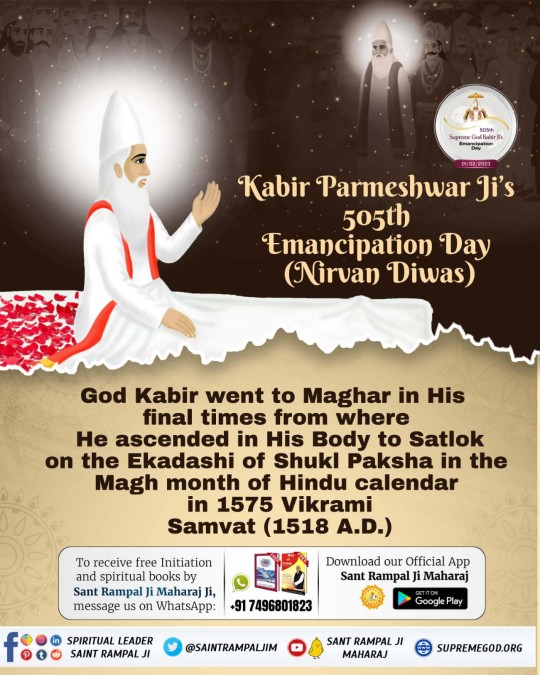
8 notes
·
View notes
Text
Exploring the Bull: A Symbol of Power Sacrifice and Fertility in Ancient Cultures
Exploring the Bull: A Symbol of Power, Sacrifice and Fertility in Ancient Cultures 🌍
https://www.youtube.com/watch?v=gxx9V9kRPac
Exploring the Bull: A Symbol of Power and Fertility in Ancient Cultures 🌍
In this captivating video, We navigate the 7 seas with Flat Arch'E 5000 to delve into the rich history and esoteric meaning of the bull across various ancient civilizations. From the Mesopotamian sacred bulls of Anu to the revered Apis bull in ancient Egypt, the bull has always been more than just a farm animal; it’s a potent symbol of strength, fertility, and divine connection.
In ancient Sumer, the bull was honored as a celestial creature, representing the power of the heavens and the earth's fertility. It was linked to the god Enlil and Innanna, embodying the life cycle and seasonal renewal. Similarly, in the fascinating world of Babylonian mythology, the Bull of Heaven is a formidable character in the Epic of Gilgamesh, symbolizing both wrath and fertility.
Shift your gaze to the Minoan civilization, where the bull's significance exploded through the iconic Minotaur legend. Here, the bull represents the dual nature of humanity—strength intertwined with monstrosity, pushing boundaries between civilization and chaos. In Hindu culture, the bull is deeply revered as Nandi, the sacred vehicle of Lord Shiva, representing not only power but also devotion and spiritual awakening.
Throughout the ages, the bull has been a transformative symbol across cultures, often portrayed in sacred art, rituals, and mythology. But what deeper meanings lie beneath the surface? Join us as we explore how the bull has shaped agricultural practices, spiritual beliefs, and societal structures, and how its legacy continues to resonate in modern symbolism.
Whether you're a history buff, mythology enthusiast, or simply curious about ancient cultures, this journey will illuminate the profound symbolism of the bull and its impact on human civilization. Don't forget to like, subscribe, and hit the notification bell for more fascinating explorations of ancient wisdom and cultural significance! 🐂✨
via Flat Arch'E 5000 https://www.youtube.com/channel/UCNcCEKVUhlSWInNeWqJhlWg
August 15, 2024 at 10:53AM
#esoteric#metaphysical#exploration#unravelthemysteries#universe#ancientwisdom#hiddenknowledge#spirit#cosmos#personalgrowth
0 notes
Text

The superiority of Hinduism
In Gita Chapter 18 Verse 62, the giver of the knowledge of Gita has said,
Tam', ev, sharanam, gachha, sarvabhaven, India,
Tatprasadat, param', shantim', sthanam', prapsyasi, shashwatam.. 62।।
That is, O India! Take refuge in God in every way. Only by the grace of that God will you attain the supreme peace and the eternal supreme abode i.e. Satyalok. But Hindu religious leaders engaged in devotion to Shri Krishna.
#हिन्दूधर्म_की_श्रेष्ठता #hinduism #hindu #sanatandharma #vedicastrology #hindustan #hindutemple #hindugods #scripture #bhagavadgita #gita #mahadev #mahabharat #mahabaleshwar #jaishreeram #jaimahakal #shiv #krishna
#viralreelschallenge
#SantRampalJiMaharaj
👉 For more information, order the book "Gyan Ganga" written by #SantRampalJiMaharaj. Book & Its Delivery, Both are completely free.
Click on the link below.
⬇️𝙊𝙧𝙙𝙚𝙧 𝙉𝙤𝙬⬇️
https://docs.google.com/forms/d/e/1FAIpQLSeWyoUZ5x6KexaDTRItkF44Wv-5mZsEdNpsJOS0LEedSIAgcw/viewform?usp=sf_link
Or
Whatsapp us your name, full address, pincode and mobile number⤵️
+91 7496801825
➡️ Install 'Sant Rampal Ji Maharaj' App from Playstore. In this app, you will be able to listen to the Gyan-Ganga Audio Book.
➡️Must Listen to the spiritual discourses of Saint Rampal Ji :-
➜ Sadhana TV 📺 7:30 pm
Shardha TV 2.00 pm to 3.00 pm
Visit 👉 Satlok Ashram YouTube channel....
0 notes
Text
The superiority of Hinduism
In Gita Chapter 18 Verse 62, the giver of the knowledge of Gita has said,
Tam', ev, sharanam, gachha, sarvabhaven, India,
Tatprasadat, param', shantim', sthanam', prapsyasi, shashwatam.. 62।।
That is, O India! Take refuge in God in every way. Only by the grace of that God will you attain the supreme peace and the eternal supreme abode i.e. Satyalok. But Hindu religious leaders engaged in devotion to Shri Krishna.
#हिन्दूधर्म_की_श्रेष्ठता #hinduism #hindu #sanatandharma #vedicastrology #hindustan #hindutemple #hindugods #scripture #bhagavadgita #gita #mahadev #mahabharat #mahabaleshwar #jaishreeram #jaimahakal #shiv #krishna
#viralreelschallenge
#SantRampalJiMaharaj
👉 For more information, order the book "Gyan Ganga" written by #SantRampalJiMaharaj. Book & Its Delivery, Both are completely free.
Click on the link below.
⬇️𝙊𝙧𝙙𝙚𝙧 𝙉𝙤𝙬⬇️
https://docs.google.com/forms/d/e/1FAIpQLScZGqmo0_LsKsA6vF3x8KDn8mQ0yaC6RM1tRSjDdsG1TNngdw/viewform?usp=sf_link
Or
Whatsapp us your name, full address, pincode and mobile number⤵️
+91 7496801825
➡️ Install 'Sant Rampal Ji Maharaj' App from Playstore. In this app, you will be able to listen to the Gyan-Ganga Audio Book.
➡️Must Listen to the spiritual discourses of Saint Rampal Ji :-
➜ Sadhana TV 📺 7:30 pm
Shardha TV 2.00 pm to 3.00 pm
Visit 👉 Satlok Ashram YouTube channel....

0 notes
Text
Narmadeshwar Shivling: A Sacred Symbol of Devotion and Divine Energy
In Hindu spirituality, the Narmadeshwar Shivling holds a unique and revered place. This sacred object, often associated with profound devotion and divine energy, is a vital symbol of Lord Shiva. Known for its purity and spiritual significance, the Narmadeshwar Shivling is more than just a religious artifact; it embodies a deep connection to the divine and serves as a focal point for worship and meditation.

What is the Narmadeshwar Shivling?
The Narmadeshwar Shivling is a specific type of Shivling—a representation of Lord Shiva, one of the principal deities in Hinduism. The term "Narmadeshwar" refers to Shivlings that are carved from stones found in or around the Narmada River, a sacred river in India. These Shivlings are believed to have been naturally formed or shaped by divine intervention, endowing them with unique spiritual qualities.
The Narmada River, which flows through the central part of India, is considered highly sacred. In Hindu tradition, it is believed that the river was created by Lord Shiva himself. As such, stones from this river are imbued with his divine energy, making them highly revered among devotees.
Historical and Spiritual Significance
The historical significance of the Narmadeshwar Shivling is deeply intertwined with Hindu mythology and spirituality. According to ancient texts and traditions, the Narmada River has a direct connection to Lord Shiva, which is considered the source of its purity. As a result, Shivlings made from stones sourced from this river are thought to possess special divine attributes, enhancing their role in spiritual practices.
In Hindu philosophy, the Shivling represents Lord Shiva in his abstract, formless aspect. Unlike depictions of Shiva with human features, the Shivling is a geometric form that symbolizes the infinite and eternal nature of the divine. It is a potent symbol of creation, preservation, and destruction—the three fundamental aspects of existence according to Hindu beliefs.
Symbolism and Spiritual Energy
The Narmadeshwar Shivling, like all Shivlings, is a symbol of cosmic energy. Its cylindrical shape with a rounded top signifies the unmanifested and infinite nature of Lord Shiva. The smooth, often polished surface of the Shivling is thought to represent purity and the unchanging essence of the divine.
Devotees believe that the Narmadeshwar Shivling channels divine energy, creating a sacred space conducive to meditation and spiritual growth. The energy radiating from the Shivling is said to aid in the purification of the mind and soul, helping individuals align themselves with higher spiritual truths.
Rituals and Worship
Worshipping the Narmadeshwar Shivling involves a variety of rituals, each designed to honor Lord Shiva and cultivate a deeper connection with the divine. One of the central practices is the Abhishekam—a ceremonial bathing of the Shivling with sacred substances such as water, milk, honey, and ghee. This ritual is performed to purify both the Shivling and the devotee, symbolizing the flow of divine grace and energy.
Daily worship of the Narmadeshwar Shivling at home or in temples typically includes offerings of flowers, fruits, and incense. Mantras and prayers dedicated to Lord Shiva are recited, creating a spiritually charged atmosphere. Special festivals, such as Maha Shivaratri, see more elaborate ceremonies, with devotees coming together to celebrate and honor the divine presence embodied by the Shivling.
Metaphysical Aspects
From a metaphysical perspective, the Narmadeshwar Shivling is more than just a physical object; it is believed to be a conduit for divine energy. According to Vedic texts, Shivlings, especially those from sacred rivers like the Narmada, help in aligning the worshipper’s energy with cosmic forces. This alignment is thought to enhance spiritual experiences and aid in personal transformation.
The natural formation of the Narmadeshwar Shivling, often smooth and cylindrical, is symbolic of the cosmic order. The base of the Shivling represents the foundation of the universe, while the central projection signifies the cosmic axis or the center of creation. This form reflects the belief that Lord Shiva is the ultimate source of all existence and divine energy.
The Devotee’s Experience
For many devotees, the Narmadeshwar Shivling is a source of profound spiritual inspiration. The act of worshipping this sacred Shivling fosters a deep sense of connection with Lord Shiva, promoting inner peace and spiritual clarity. The experience of engaging with the Shivling is often described as transformative, offering insights into the nature of the divine and the self. In summary, the Narmadeshwar Shivling stands as a powerful symbol of devotion and divine energy. Its origins from the sacred Narmada River, combined with its representation of Lord Shiva, make it a cherished object of worship. Whether through daily rituals or during special festivals, the Narmadeshwar Shivling continues to inspire and elevate the spiritual lives of countless devotees, bridging the gap between the mortal and the divine.
#har har mahadev#hare krishna#shiva#lord shiva#hare rama#narmada shivling#narmadeshwar shivling for home#shivling
0 notes
Text
Navratri 2024 Colors: A Guide to the Significance of 9 Days of Sharad Navratri Attire

Navratri, the nine-night festival dedicated to the worship of Goddess Durga, is celebrated with great enthusiasm and devotion in India, especially in states like Maharashtra and Gujarat. One of the captivating traditions during Navratri is the daily choice of colors to wear, each associated with a different form of the goddess. This practice holds deep significance in Hindu culture, symbolizing purity. Let's take a closer look at the Navratri colors to be followed this year and the gods and goddesses they represent.
Day 1: Pratipada - Shailputri
On the first day of Navratri, Goddess Shailputri is venerated, also known as Parvati, the daughter of the Himalaya mountains. The color for this day is Orange, symbolizing energy and enthusiasm.
Image Courtesy: Pinterest
Adorn yourself in an elegant Orange and red Ikkat Pure Pochampally Handloom Saree to honor the goddess's strength and grace.

Day 2: Dwitiya - Brahmacharini
Mata Brahmacharini, the goddess celebrated on the second day, signifies eternal peace. White, the color of serenity, is the choice for Day 2.

Image Courtesy: Online live daily news
A Pearl White Color Mirror Work Viscose Rayon Navaratri Lehenga Choli reflects the goddess's tranquil and pure nature.

Day 3: Tritiya - Chandraghanta
On Tritiya, we worship Mata Chandraghanta, who rides a lion and is believed to vanquish evil forces. Red, the color of health, courage, and love, is the color of choice.

Image Courtesy: Pinterest
Embrace this vibrant hue with a Red saree cutdana work to channel your inner strength.

Day 4: Chaturthi - Kushmanda
The fourth day celebrates Mata Kushmanda, who is said to have created the cosmic egg with her smile, bringing light to the universe. Royal Blue, representing elegance and royalty, is the color for this day.

Image Courtesy: Pinterest
Grace the occasion with a splendid Navratri Chaniya Choli in this mesmerizing shade of Blue.

Day 5: Panchami - SkandMata
Mata Skandmata, honored on the fifth day, is associated with good health. This day is dedicated to Green, symbolizing nature and prosperity.

Image Courtesy: Pinterest
Wear this beautiful green saree to align with the goddess's blessings.

Day 6: Shashthi - Katyayani
Mata Katyayani, the sixth form of Mata Durga, is the granter of health and happiness. Grey, a vibrant and versatile color, is chosen for this day's celebrations.
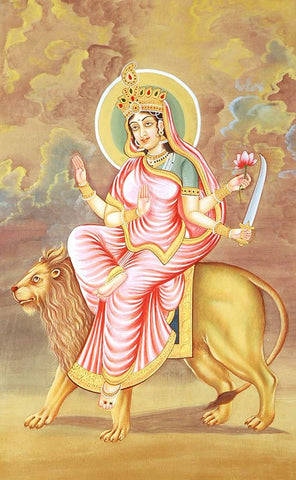
Image Courtesy: Pinterest
Grace the occasion with a Grey Anarkali Dress

Day 7: Saptami - Kaalratri
Maa Kaalratri, worshipped on the seventh day, protects against evil forces. Orange is the color for Saptami, reflecting the fervor of Navratri celebrations.

Day 8: Ashtami - Mahagauri
Maa Mahagauri, associated with peace and intelligence, is revered on the eighth day.

Image Courtesy: Pinterest
Adorn yourself in Peacock Green indian saree, a sublime shade that complements the goddess's virtues.

Day 9: Navami - Siddhidatri
On the ninth and final day, we honor Maa Siddhidatri, the granter of divine blessings. Pink, a combination of the energy of red and the stability of blue, is chosen. This color symbolizes opulence and richness as we seek the goddess's supreme blessings.

Image Courtesy: Pinterest
During Navratri, people wear different colors each day to show that they are all together and devoted. It's like a colorful journey through different forms of the Goddess Durga, who is very special. When you celebrate Navratri, make sure to wear colors that show how much you love and respect the divine.
Explore the exquisite collection of Navratri attire at Mohi Fashion, featuring enchanting Chaniya Choli, Navratri Ghagra Choli, Anarkali suit, sarees, and stylish sharara suit, all available online. We proudly offer worldwide shipping, catering to fashion enthusiasts in the USA, Australia, UK, Canada, India, and beyond. Join us in celebrating the spirit of Navratri with elegance and style.
More:
Navratri Chaniya Choli
Guide to the Significance of Navratri
Garba: Significance of Garba Forms in Navaratri
Dressing Up for Dandiya Night
1st day Navratri | Maa Shailputri
#navratri#garba#dandiya#durga puja#lehenga choli#wedding guest dresses#indian wedding dresses#indian ethnic wear
0 notes